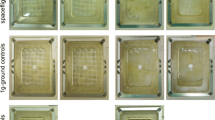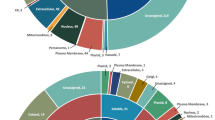Abstract
One of the important questions in space biology is the mechanisms underlying plant responses to an outer space environment, i.e., how gene expression is altered in space. In this study, the transcriptome of Arabidopsis thaliana seedlings was analyzed as a part of Germany SIMBOX (science in microgravity box) spaceflight experiment on Shenzhou 8 spacecraft. This experiment involved the following treatments: spaceflight with microgravity (F μg), spaceflight with 1g centrifugal force (F 1g), and ground 1g control (G 1g). Gene chips were used to screen gene expression differences in Arabidopsis thaliana seedlings among these treatments. Microarray analysis revealed that 621 genes were differentially expressed in samples F μg vs. G 1g, 249 genes in samples F 1g vs. G 1g, and 368 genes in samples F μg vs. F 1g. Gene ontology analysis indicated that the genes were involved in metabolism of stress response, gravitropic response, and DNA damage and repair, suggesting that plants adjust these metabolic pathways to space environmental stress, microgravity, and radiation.
Similar content being viewed by others
References
Paul A L, Zupanska A K, Ostrow D T, et al. Spaceflight transcriptomes: Unique responses to a novel environment. Astrobiology, 2012, 12: 40–56
Des Marais D J, Nuth J A, Allamandola L J, et al. The NASA Astrobiology roadmap. Astrobiology, 2008, 8: 715–730
Paul A L, Daugherty C J, Bihn E A, et al. Transgene expression patterns indicate that spaceflight affects stress signal perception and transduction in Arabidopsis. Plant Physiol, 2001, 126: 613–621
Zhang Y, Wang L, Xie J, et al. Differential protein expression profiling of Arabidopsis thaliana callus under microgravity on board the Chinese SZ-8 spacecraft. Planta, 2014, 241: 475–488
Hausmann N, Fengler S, Hennig A, et al. Cytosolic calcium, hydrogen peroxide and related gene expression and protein modulation in Arabidopsis thaliana cell cultures respond immediately to altered gravitation: Parabolic flight data. Plant Biol (Stuttg), 2014, 16 (Suppl 1): 120–128
Merkys A, Darginaviciene J. Plant gravitropic response. Adv Space Biol Med, 1997, 6: 213–230
Klymchuk D O, Kordyum E L, Vorobyova T V, et al. Changes in vacuolation in the root apex cells of soybean seedlings in microgravity. Adv Space Res, 2003, 31: 2283–2288
Roux S J, Chatterjee A, Hillier S, et al. Early development of fern gametophytes in microgravity. Adv Space Res, 2003, 31: 215–220
Salmi M L, Roux S J. Gene expression changes induced by space flight in single-cells of the fern Ceratopteris richardii. Planta, 2008, 229: 151–159
Correll M J, Pyle T P, Millar K D, et al. Transcriptome analyses of Arabidopsis thaliana seedlings grown in space: Implications for gravity-responsive genes. Planta, 2013, 238: 519–533
Paul A L, Popp M P, Gurley W B, et al. Arabidopsis gene expression patterns are altered during spaceflight. In: Space Life Sciences: Gravity-Related Effects on Plants and Spaceflight and Man-Made Environments on Biological Systems, vol. 36. Oxford: Elsevier Science Ltd, 2005. 1175–1181
Shagimardanova E I, Gusev O A, Sychev V N, et al. Stress response genes expression analysis of barley Hordeum vulgare under space flight environment. Mol Biol (Mosk), 2010, 44: 831–838
Stutte G W, Monje O, Hatfield R D, et al. Microgravity effects on leaf morphology, cell structure, carbon metabolism and mRNA expression of dwarf wheat. Planta, 2006, 224: 1038–1049
Paul A L, Manak M S, Mayfield J D, et al. Parabolic flight induces changes in gene expression patterns in Arabidopsis thaliana. Astrobiology, 2011, 11: 743–758
Fengler S, Spirer I, Neef M, et al. A whole-genome microarray study of Arabidopsis thaliana semisolid callus cultures exposed to microgravity and nonmicrogravity related spaceflight conditions for 5 days on board of Shenzhou 8. Biomed Res Int, 2015, 2015: 547495
Dubois F, Tercé-Laforgue T, Gonzalez-Moro M B, et al. Glutamate dehydrogenase in plants: Is there a new story for an old enzyme? Plant Physiol Bioch, 2003, 41: 565–576
Aubert Y, Vile D, Pervent M, et al. RD20, a stress-inducible caleosin, participates in stomatal control, transpiration and drought tolerance in Arabidopsis thaliana. Plant Cell Physiol, 2010, 51: 1975–1987
Kim Y Y, Jung K W, Yoo K S, et al. A stress-responsive caleosin- like protein, AtCLO4, acts as a negative regulator of ABA responses in Arabidopsis. Plant Physiol, 2011, 52: 874–884
Hashimoto K, Eckert C, Anschutz U, et al. Phosphorylation of calcineurin B-like (CBL) calcium sensor proteins by their CBL-interacting protein kinases (CIPKs) is required for full activity of CBLCIPK complexes toward their target proteins. J Biol Chem, 2012, 287: 7956–7968
Zupanska A K, Denison F C, Ferl R J, et al. Spaceflight engages heat shock protein and other molecular chaperone genes in tissue culture cells of Arabidopsis thaliana. Am J Bot, 2013, 100: 235–248
Qi B, Zheng H. Modulation of root-skewing responses by KNAT1 in Arabidopsis thaliana. Plant J, 2013, 76: 380–392
Karasev A V, Kashina A S, Gelfand V I, et al. HSP70-related 65 kDa protein of beet yellows closterovirus is a microtubule-binding protein. Febs Lett, 1992, 304: 12–14
Sun W, Bernard C, Van De Cotte B, et al. At-HSP17.6A, encoding a small heat shock protein in Arabidopsis, can enhance osmotolerance upon overexpression. Plant J, 2001, 27: 407–415
Goyal K, Walton L, Tunnacliffe A. LEA proteins prevent protein aggregation due to water stress. Biochem J, 2005, 388: 151–157
Pang Q, Hays J B, Rajagopal I. A plant cDNA that partially complements Escherichia coli recA mutations predicts a polypeptide not strongly homologous to RecA proteins. Proc Natl Acad Sci USA, 1992, 89: 8073–8077
Chen H, Gong Y, Han R. Cadmium telluride quantum dots (CdTe-QDs) and enhanced ultraviolet-B (UV-B) radiation trigger antioxidant enzyme metabolism and programmed cell death in wheat seedlings. PLoS One, 2014, 9: e110400
Aubert Y, Vile D, Pervent M, et al. RD20, a stress-inducible caleosin, participates in stomatal control, transpiration and drought tolerance in Arabidopsis thaliana. Plant Cell Physiol, 2010, 51: 1975–1987
Porterfield D M, Matthews S W, Daugherty C J, et al. Spaceflight exposure effects on transcription, activity, and localization of alcohol dehydrogenase in the roots of Arabidopsis thaliana. Plant Physiol, 1997, 113: 685–693
Kimbrough J M, Salinas-Mondragon R, Boss W F, et al. The fast and transient transcriptional network of gravity and mechanical stimulation in the Arabidopsis root apex. Plant Physiol, 2004, 136: 2790–2805
Author information
Authors and Affiliations
Corresponding author
Additional information
These authors contributed equally to this work
Electronic supplementary material
11431_2016_232_MOESM1_ESM.doc
Differentially expressed genes (fold change >5) in samples of three treatments. Note: “a” represents 18 common genes in three treatments which expression were significant changed. “-” represents cannot get the reliable value
11431_2016_232_MOESM2_ESM.doc
Agarose gel analysis of extracted RNA from ground control (G 1g) on-board 1g centrifuge (F 1g), spaceflight (F μg) samples, front and rear CC (Culture Chamber)
Rights and permissions
About this article
Cite this article
Li, H., Lu, J., Zhao, H. et al. The impact of space environment on gene expression in Arabidopsis thaliana seedlings. Sci. China Technol. Sci. 60, 902–910 (2017). https://doi.org/10.1007/s11431-016-0232-7
Received:
Accepted:
Published:
Issue Date:
DOI: https://doi.org/10.1007/s11431-016-0232-7




